Duane Keiser is perhaps best known as the leading pioneer in the trend of painters selling work online. He is not only a fabulous painter who has sold work in major NYC galleries but continues to be a leading figure “in democratizing the art world, using the Internet to change the making and selling of art” as a 2006 article in USA Today discussed.
In another article in the New York Times written by Michelle Slatalla in August 31, 2006
“By most accounts, the roots of the painting-a-day movement reach back only as far as December 2004, when a painter named Duane Keiser, who also is an adjunct professor at the University of Richmond in Virginia, decided to test his discipline by challenging himself to post a new creation every day on his site at duanekeiser.blogspot.com.
“I wanted to make a ritual for myself, to complete a painting in one day, every day, without any excuses,” Mr. Keiser said in a phone interview last week. “I liked the diary aspect of it, that it was like putting a time stamp on a painting. When it goes up on the blog, I know it happened on this day.”
Mr. Keiser’s experiment soon attracted the attention of boingboing.net, a popular blog that identifies online trends.
“After somebody wrote a little blurb about me for Boingboing, the whole thing just spread like, well, it was unbelievable,” Mr. Keiser said. “I would wake up in the morning and paint, say, an egg, and post it, and then some guy in India would e-mail me and it was breathtaking to realize that within a few minutes of my finishing a painting, people everywhere in the world were looking at it.”
Previously, Mr. Keiser sold most of his work through traditional brick-and-mortar galleries. “But this has allowed me the flexibility to not worry about whether a gallery will accept me,” he said.
When asked about his pricing stats, Keiser stated: “The blog was launched in 2004. I’ve posted about 1,300 daily paintings since then. All but a handful have sold. The highest selling price was around $1,500; the lowest was $79.”
Many articles written and interview conducted with Duane Keiser, a selection are available on Keiser’s website. My favorite interview was with interviewer John Seed of the Huffington Post who discusses his Painting a Day approach and work in depth in his 2013 interview.
I’ve been following Duane’s blog since it’s beginning. His seductive and rich painterly style and ability to resolve a painting in one sitting combined with brilliant internet marketing savvy has helped insure the success in his painting a day blog when many other painters who tried to copy his approach failed, either due to not having an internet presence or lack of vision and skill. Suffice to say, Keiser positioned himself to be in a perfect convergence of not only being a terrific painter with early internet attention but also that he wired into the central nerves of regular people. Not just art collectors but many people who were buying art for the first time, wanting to bring meaningful, beautiful and affordable paintings into their lives. Perhaps, helping to spawn a new generation of art lovers who may be willing to help other painters with buying work.
In this interview I wanted to focus more about his process and thoughts on painting rather than the ins and outs of selling work online, other interviews have already covered this in depth. I would like to thank Duane Keiser for taking the time to respond to my email interview with such engaging and thoughtful answers.
[slideshow_deploy id=’4557’]Above is a slide show of 40+ selected painting that I particularly enjoy, chosen primarily from his painting a day blog archive.
Duane Keiser was born in 1966 in Beaufort, South Carolina. He studied with Raymond Berry at the Randolph-Macon College in Virginia and also studied with Lennart Anderson and received MFA at the Brooklyn College in 1990.
Has taught as a Adjunct Professor of Art at the Randolph-Macon College, Ashland, Virginia and the University of Richmond, Richmond, Virginia
Shown in many venues including group shows with the Allan Stone gallery and solo shows at the Fischbach Gallery in New York and participated in the 2011 Group Exhibition, “Persistence of Vision: The Peterson Collection of Contemporary Realist Art,” New York Academy of Art, New York. He has received many awards including the Richard Estes Acadia Foundation Grant, 2008
[caption id=”attachment_4574″ align=”aligncenter” width=”400″]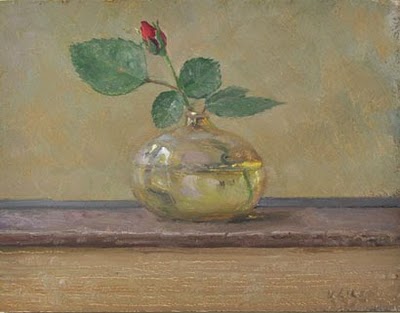 “Rosebud on a Book, 8/26/2010″ oil/linen 5″x6”[/caption]
“Rosebud on a Book, 8/26/2010″ oil/linen 5″x6”[/caption]
Larry Groff: Please tell us what lead you to become a painter you are today? Who were your most important early influences?
Duane Keiser Most of my current work addresses themes that can be traced back to the years I studied under Ray Berry as an undergraduate at Randolph-Macon College. But I can’t talk about early influences without mentioning the place where Ray taught me to paint–Pace Hall. Pace was built in 1876 and has been restored, but when I was a student in the mid-1980s, the second and third floors were condemned, and the first floor, which housed the art department, wasn’t much better. But the rooms were large and high-ceilinged with original bottle glass windows that lit the space like a cathedral. Up until the 1960s, Pace had served as the science building. Amazingly, there were still chemistry formulas written on the chalkboards in the abandoned labs upstairs, and old test tubes (and the occasional mummified dead bird) lying around. It was beautiful and haunting. Ray gave me the key to the building and I spent many days and nights making paintings of the interior. Pace was where I discovered Rembrandt, Vermeer, and Hopper. It inspired my fascination with light and night. It was where I began to understand what Bachelard called the “poetics of space.” It is where I first began making small premier coup paintings of sunbeams as they moved across the cracked and peeling walls. That exercise would eventually grow into my Painting a Day project.
LG: You’ve made several landscapes and teach a plein air workshop at Luck’s Farm in Virginia. I understand you sometimes paint there with your former painting and Karate teacher, the painter Raymond Berry. What is special about your teacher and this place that you return so often?
DK: You’d never know that Luck’s farm is only five minutes from Randolph-Macon College. It’s off the beaten path and hidden from the main road. The owner has very generously granted the College permission to conduct painting classes there. The landscape includes small bodies of water nestled among several acres of gently rolling farmland that’s divided by rows of trees. Constable would have loved it. It’s quiet and subtle, and it delivers new surprises every season. Ray and I–Ray, especially–have come to know it very well over the years. Whenever I see one of his Luck’s Farm paintings, I always know exactly where he stood, and often recognize individual trees and bushes. He recently devised a method to paint encaustic out in the field. His new work is truly sublime.
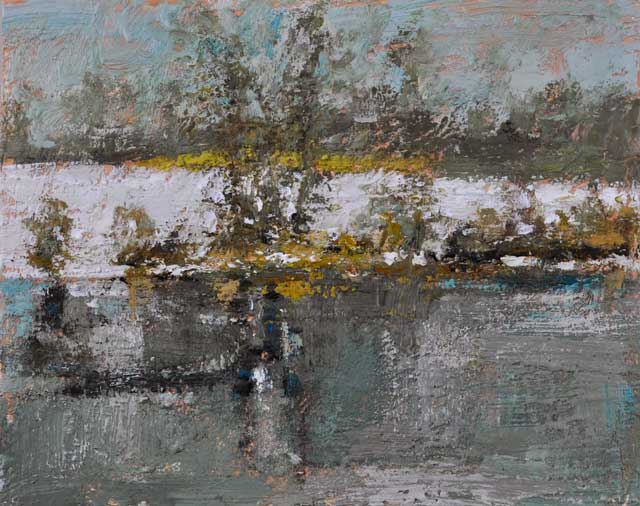
Raymond Berry, Luck’s Farm, Frozen Pond Looking East, January 23, 2014, Encaustic on Board, 8″ x 10″
Ray is one of those extremely rare teachers who has a vast and deep pool of experience to draw from and an uncanny ability to pass it along to his students in a way that’s both poetic and clear. He’s an intuitive teacher–he knows what a student needs to know, and when he or she needs to know it. A testimony to his gift is the fact that his students all paint very differently from one another, and from him. There is no “house style” in his department. As a teacher myself, I know how tempting it is to devise little systems for my students to follow, rather than teach them the hard-to-grasp principles of seeing, perception, and practice that will enable them to develop in their own way. He has changed my life in many ways, and I feel lucky to have met him.
LG: You studied with Lennart Anderson at Brooklyn College graduating in 1990. I can see some affinities with some of his still-life subjects such as his Jiffy-Pop painting and your work. How influential was Lennart’s teaching to your work?
DK: I’ve always loved those jiffy pop paintings. Lennart has been very influential in that I’m still processing what he taught me at Brooklyn College 25 years ago. His teaching is very direct and honest (like his painting) and to this day, I have not seen a painter with an eye as refined as his. A few of us got to watch him begin a painting in one of his Saturday morning figure classes. As we looked over his shoulder, I remember thinking he painted like a five-year old–pressing his finger onto the canvas, scraping, smearing. No tension. There was this sense of someone seeing very purely with no assumptions or ego. He took obvious joy in the problems of painting and of seeing. It was wonderful to watch. If painting is a silent dialogue between the painter and the subject, then Lennart is a supreme listener. After fifteen minutes, I could barely discern the figure in his painting, but then he put a couple of perfectly placed notes of color down and a thigh appeared–a solid, beautiful thigh. The amazing thing is that it seemed to surprise him, too. It was as if he was so enthralled with the colors and paint that he forgot that about the figure. It was astounding. I recall that moment as a perfect example of an expert with a beginner’s mind.
LG: You recently posted on your website what you call Transitory Paintings, one of Luck’s Farm as well as a painting from your window. These videos show a slideshow of the paintings many incarnations, like a slideshow of photos starting with a child and ending with an adult all from the same location and position. You painted over some stunning paintings and I wanted to cry seeing them being buried alive like that! You make dramatic changes, not just minor revisions to these paintings. I was dumbfounded after reading that you plan to have the buyer agree that you will take back the painting periodically to repaint it. Having an “open relationship” with old lovers might sound like good idea in theory but won’t it create complications with your current sweetheart? Please tell us something more about what lead you to this fascinating new venture.
DK: I “finished” a small interior of my studio window a few years ago but then kept noticing something interesting happening with specific elements, like the light on the wall, or the trees outside the window, so I’d take the painting down and work back into it. I kept doing this until I realized I had a completely different painting–what started out an overcast winter painting ended up a sunny spring painting. So I decided to see if could make a continuous painting that changed as my subject changed. At first, working this way seemed half-crazy but after some time it began to feel normal and it became a meditation. I began to enjoy how the surface built up and that the pentimenti came to serve as a visual metaphor for transience and change. My goal is to hang the painting on the wall with a large touchscreen playing a slideshow that allows the viewer to select previous iterations of the painting. The fact that past iterations are gone and the current one will be gone soon, too, makes the sense of transience and loss more palpable than if the viewer were looking at a series of separate paintings.
The couple with whom I have this “open relationship” are dear friends who have bravely agreed to serve as my guinea pigs. They bought the Luck’s Farm painting with the understanding that I could drop by any time, take the painting off the wall, and paint a new iteration of their Luck’s landscape. They’ve been great about it. I know they prefer some iterations to others, but they keep their opinions to themselves and allow me the freedom to work without pressure.. At some point, we’ll come to an agreement on when to stop.
How does your small premier-coup painting inform your larger paintings done over multiple sessions? Do you really make a new painting every day or do you go through periods when you put that aside?
DK: Premier coup painting has given me more freedom and flexibility in my larger work–to the point where the lines between the two modes of painting have blurred. Many of the great paintings I love have aspects of both. One reason Las Meninas has such an intense verisimilitude is that Velazqueuz could shift seamlessly between quick and sketchy and slow and deliberate, to parallel the glances and gazes of visual perception.
When I started back in 2004, I made one painting every day for about a year-and-a-half. Since then, there have been brief periods when I’ll stop to work on other projects or to re-group and clear my mind.
I understand you’ve been practicing Shotokan Karate for almost 30 years. You stated in a 2006 interview (I will link) that your painting informs your Karate and vice-versa. Much of the martial arts I imagine would involve repetition of certain moves in a meditative-type fashion but in painting I would think repetition of moves might risk becoming formulaic. I’m curious if you can give some examples of specifically how this has played out for you in your work.
DK: There is a great deal of repetition in this particular style of karate, but ideally, it’s a mindful repetition. By this, I mean that when you repeat a technique a thousand times in a row, you are trying to make each technique your best, each time. You won’t, but that’s the goal. You have to learn to actively resist the temptation to go through the motions, to phone it in. It’s the same with painting or any other creative endeavor. But with A Painting a Day, the problem is particularly acute because of the frequency of the process and the self-imposed deadline. It’s easy for painterly efficiencies to become habits, and for habits to become mindless algorithms. It requires a constant vigilance to avoid sleepwalking. I should add that I’ve stopped my SKA practice, but what I learned from it plays an active role in everything I do.
LG:Do you need silence and isolation to concentrate completely on the work or are you the type of person who has music blaring, tv on with kids and pets playing and phones ringing off the hook? What helps you to make better paintings?
DK: My studio is attached to my house and I have a distractingly adorable five-year-old daughter so prolonged silence and isolation isn’t an option for me. Painting outdoors has taught me to deal with all kinds of distractions, including trains, drunks, wild animals and biblical weather, so I’m not too particular.
LG:I’ve been thinking a lot about a comment someone left on an interview with you, she quoted Edgar Degas: “Painting is easy when you don’t know how, but very difficult when you do” You replied with another Degas quote: “Only when he no longer knows what he is doing does the painter do good things.” Do you ever find that your high level of skill in painting can work against you?
DK: The fact that I have a lot of tricks and techniques to choose from only means that I have more ways to avoid dealing with the essence of a problem. So yes, my skill can work against me. I chose that particular quote because my best painting often seems to happen when I’m lost and haven’t the foggiest notion how to proceed, or when I’m on the verge of wiping off a painting in disgust. I think this is because at that point I am finally prepared to let go of those precious passages I was hanging onto at the expense of the whole. William Faulkner said, “In writing, you must kill all your darlings.” I think the same is true for painting.
LG: There seems to be more painters than ever these days, competing for spots in the few galleries left standing since the last round of economic downturns, trying to reach a rapidly shrinking collector base with artwork of every imaginable style, subject and medium, all with an incredible range of talent from work that rivals the old masters to epic imbecility. It seems hopeless and incredibly exciting at the same time. How do you feel about the painter’s chance of survival in today’s artworld? Is it worth it to stay in the traditional gallery game or better to reach collectors and new art buyers directly on your own?
DK: This is a golden age for painters. We have more options to get our work in front of fans and collectors than ever before. I don’t see the collector base contracting, I see it expanding. With an increased number of painters, I see an even larger increase in the number of collectors. It’s simple–new technology (computers, smart phones, tablets) offers direct access to artists’ studios and galleries. As a result, more people are buying art. Not just the top .001% that we constantly hear about in the news, but across a wide range of household income.
Is it worth it to stay in the traditional gallery game, or better to reach out to new art buyers on your own? The answer depends on your individual circumstances. The important thing is that this question is being asked. Twenty years ago, you wouldn’t have dreamed of asking an artist if it’s worth it to work outside the gallery system.
Generally speaking, I think it’s worth it to at least explore your selling options outside the gallery system. Some artists aren’t suited to selling their own work, which is understandable because it can take a lot of time and energy away from your painting. On the other hand, playing the gallery game can be time-consuming too and great galleries are few and far between. I’ve done it both ways. I had a good experience with Fischbach Gallery back in the 1990s, and I’ve had success as a self-represented artist.
LG: Most of your paintings aren’t just an accumulation of details or fine-tuning an image’s rendering into a photographic likeness. You seem willing to not hold anything too precious and are free to change the painting at any point right up until the very end; as you cleverly demonstrate in your egg cracking and ice cream cone paintings. What would you tell students about your reasons for not being precious with your painting and your willingness to leave the painting open right up until the end?
DK: In my first painting class with Ray Berry, each of us had a couple of hours to paint a small oil study on paper. He then asked us to line them up on the wall for a critique. After the critique, he told us to wipe the paintings off. Jaws dropped. You would have thought the Pope asked Michelangelo to take a belt sander to the Sistine chapel. And the funny thing is, none of us even liked our paintings! They were terrible, and we knew it, but it was still hard to wipe them away. Ray’s request had the intended effect of revealing our knee-jerk attachment to our work, and freeing us up to experiment and make mistakes in future paintings. In other words, it helped us realize that painting was an investigation rather than a tidy step-by-step process.
LG: You’ve had well over a half-million people watch you painting on youtube, how does this make you feel?
DK: It’s interesting to think that the number of people who watched those videos could fill up several football stadiums. On the other hand, the typical cat video on YouTube gets millions of viewers so I’m not sure the numbers alone are a big deal. Whether it’s one person or a million, I’m encouraged to know there are people who appreciate my work and want to see it.
Quote selected by Duane Keiser from Pilgrim at Tinker Creek by Annie Dillard:
There are lots of things to see, unwrapped gifts and free surprises. The world is fairly studded and strewn with pennies cast broadside from a generous hand. But — and this is the point — who gets excited by a mere penny? If you follow one arrow, if you crouch motionless on a bank to watch a tremulous ripple thrill on the water and are rewarded by the sight of a muskrat kit paddling from its den, will you count that sight a chip of copper only, and go your rueful way? It is dire poverty indeed when a man is so malnourished and fatigued that he won’t stoop to pick up a penny. But if you cultivate a healthy poverty and simplicity, so that finding a penny will literally make your day, then, since the world is in fact planted in pennies, you have with your poverty bought a lifetime of days. It is that simple. What you see is what you get.
Daily painting is woven into my life and has become a kind meditation for me; a way to practice being in the moment and appreciative of what I have. Pilgrim at Tinker Creek by Annie Dillard has had a big influence on me. This passage in particular shaped the way I approach “A Painting a Day:” (from the interview with John Seed)

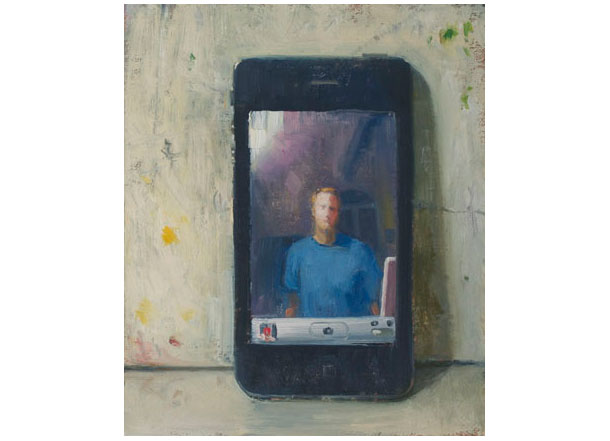
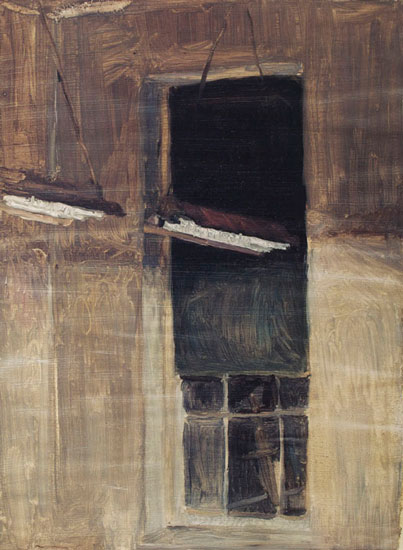

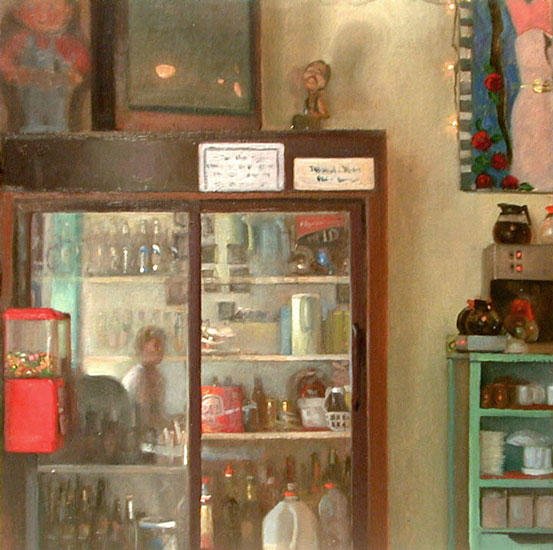
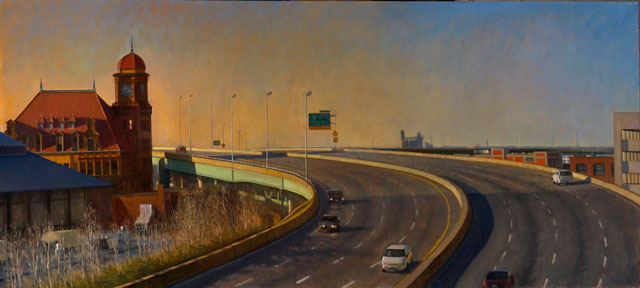
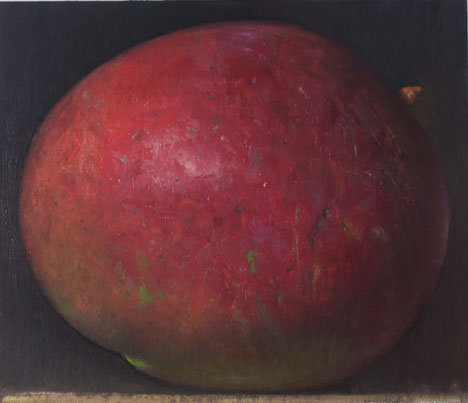
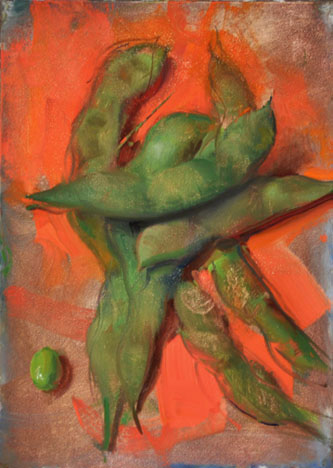
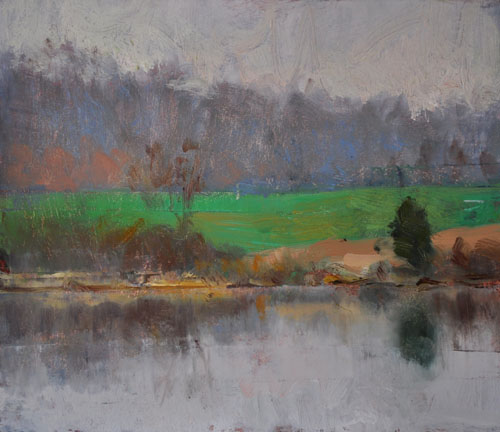
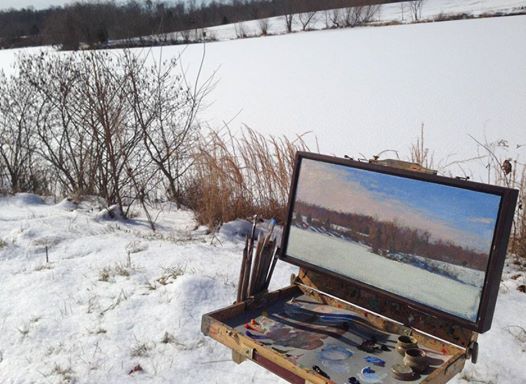
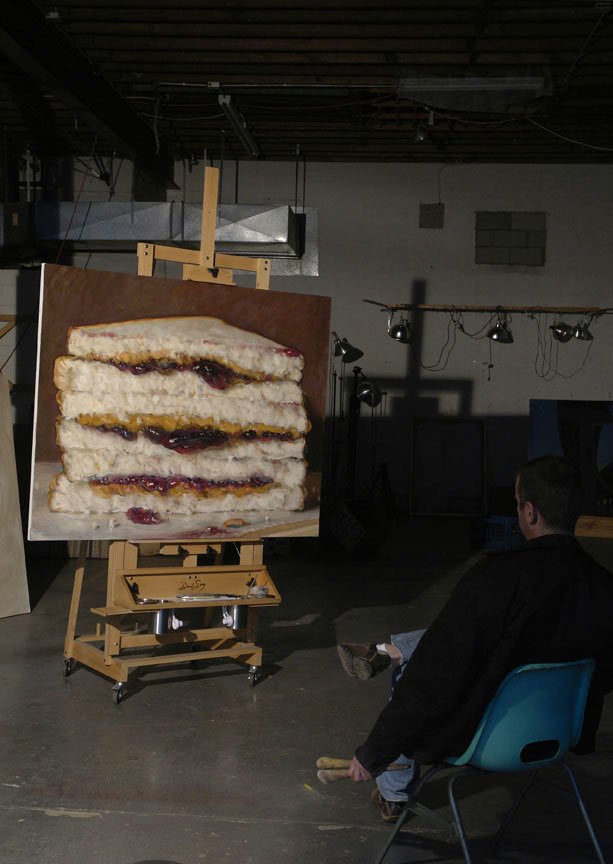






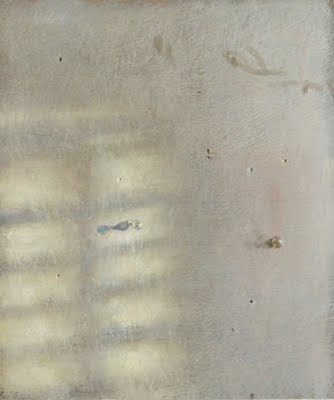

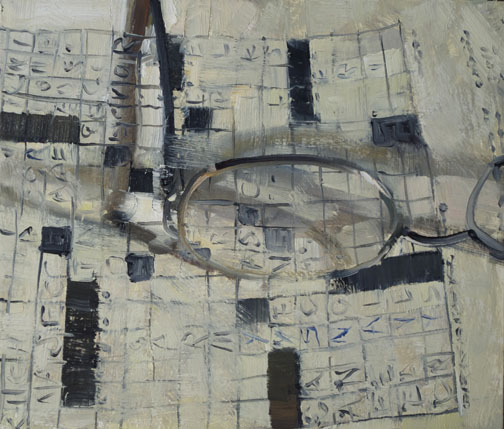
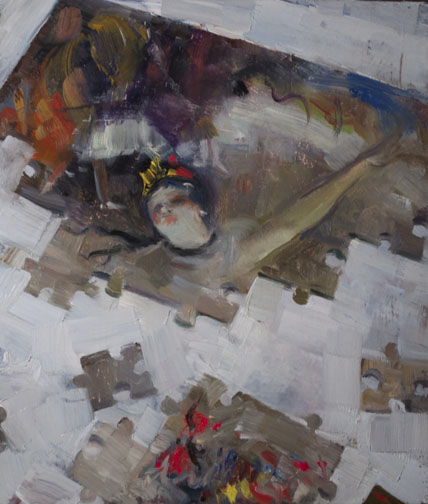
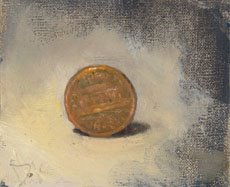






Wonderful interview. My teacher in painting recommended me to check out Duane Keiser long time ago but I haven’t done so until now. I recognize several of the paintings shown on this page. I don’t know from where but they sure have made an impression on me. I need to find out more about this man!
Thanks for delivering high quality reading, Paintingperceptions!
Wonderful! Exciting! Engaging! Does Duane do travel workshops in Europe?
These paintings are amazing in that they are diverse both in content and style. Duane is ahead of his time and will always be a magnet for painters. Wonderful article, thank you for a fabulous painter.
Duane you are awesome!! So happy to know you’re coming to Whidbey Island to teach a workshop.
Loved watching the demos.
Thanks for pioneering sales on the web. That is a BIG help
I am absolutely in awe of your paintings .
Thank you, everyone!
Wonderful interview Larry, Duane’s work is very inspiring.
I too, have followed Duane’s work since the inception of his ” painting a day” thing. The very thought of me doing that and I want to go hide in the closet in terror. The guy’s a genius in all respects. It’s thrilling to see that he’s also human, his bad days can show up occasionally but they are few and really not so bad as for me to use that word I wrote so carelessly. BUT! On his good days–and “good” is far from being descriptive of these days–on those day he is monumental. The windows rattle and the floor shakes when I open the site to view one of those unbelievable constructions of pure joy. I’m sure I’ve learned from him, I’m not certain exactly what it was but I know I’m glad for having had the opportunity to be able to see him wipe down start after start and finalize all these mis-starts with an absolute jewel. I’m still working on that part.
Thanks, Larry.
That’s a terrific interview.
I have known Duane for nearly a decade, and his work continues to grow at an enviable rate. Also, he is a FANTASTIC lecturer and teacher, so if you ever have the chance to work with him in person, by all means, do so!
I have been inspired by Duane and Robert Genn to write a blog about painting as well combining the paintings with text once a week. It has been personally very informative and a wonderful discipline and hopefully informative to other artist. Thanks for your inspiration, Duane! Paris Pruden
I have fallowed Duane Keiser’s blog for years now. He is a genius to the max!! His artwork is PURE INTELLIGENCE MADE VISUAL!!
Great interview, = very interesting indeed.
thanks , Eve
You are an inspiration to me!